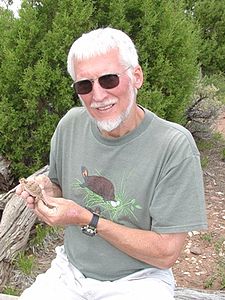
Herpetology is a branch of zoology concerned with the study of amphibians and reptiles. Birds, which are cladistically included within Reptilia, are traditionally excluded here; the separate scientific study of birds is the subject of ornithology.
Edward Harrison Taylor was an American herpetologist from Missouri.

Pseudemys is a genus of large, herbivorous, freshwater turtles of the eastern United States and adjacent northeast Mexico. They are often referred to as cooters, which stems from kuta, the word for turtle in the Bambara and Malinké languages, brought to America by enslaved people from Africa.
Malcolm Arthur Smith was a herpetologist and physician working in the Malay Peninsula.

James Ray Dixon was professor emeritus and curator emeritus of amphibians and reptiles at the Texas Cooperative Wildlife Collection at Texas A&M University. He lived in El Campo, Texas, throughout most of his childhood. He published prolifically on the subject of herpetology in his distinguished career, authoring and co-authoring several books, book chapters, and numerous peer reviewed notes and articles, describing two new genera, and many new species, earning him a reputation as one of the most prominent herpetologists of his generation. His main research focus was morphology based systematics of amphibians and reptiles worldwide with emphasis on Texas, US, Mexico, Central America, and South America, although bibliographies, conservation, ecology, life history and zoogeography have all been the subjects of his extensive publications.

Agkistrodon taylori is a species of venomous snake, a pitviper (Crotalinae) found only in northeastern Mexico. The standardized names are Taylor's cantil (English) and Metapil (Spanish), although it is sometimes called the ornate cantil as well as several other colloquial names. It was named in honor of American herpetologist Edward Harrison Taylor.
Hobart Muir Smith, born Frederick William Stouffer, was an American herpetologist. He is credited with describing more than 100 new species of American reptiles and amphibians. In addition, he has been honored by having at least six species named after him, including the southwestern blackhead snake, Smith's earth snake, Smith's arboreal alligator lizard, Hobart's anadia, Hobart Smith's anole, and Smith's rose-bellied lizard. At 100 years of age, Smith continued to be an active and productive herpetologist. Although he published on a wide range of herpetological subjects, his main focus throughout his career was on the amphibians and reptiles of Mexico, including taxonomy, bibliographies, and history. Having published more than 1,600 manuscripts, he surpassed all contemporaries and remains the most published herpetologist of all time.
The Society for the Study of Amphibians and Reptiles (SSAR) is an international herpetological society. It is a non-profit organization supporting education, conservation, and research related to reptiles and amphibians. Regular publications include the Journal of Herpetology and Herpetological Review. It is the largest international herpetological society, and is recognized worldwide for having the most diverse program of publications, meetings, and other activities.
Erythrolamprus ornatus, also known commonly as the ornate ground snake and the Saint Lucia racer, is a species of snake in the family Colubridae. The species is native to the eastern Caribbean. It is the rarest snake on earth with fewer than 20 left in the wild.

Ctenosaura acanthura, is a species of iguanid lizard found in eastern Mexico and extreme western Guatemala. The standardized English name is the Mexican spiny-tailed iguana. Confusingly however, an earlier edition of standardized names for Mexican herpetofauna called Ctenosaura acanthura the northeastern spinytailed iguana and applied the name Mexican spinytailed iguana to Ctenosaura pectinata, which was called the western spiny-tailed iguana in the second edition. It has also been referred to as the Veracruz spiny-tailed iguana and Gulf Coast spiny-tailed iguana. It is an egg laying species that is mostly herbivorous and a moderately large lizard commonly growing over one meter in total length.

Ilya Sergeyevich Darevsky was a Soviet Russian zoologist-herpetologist and a corresponding member of the Russian Academy of Sciences. During his career he described 34 species of amphibians and reptiles. Darevskia, a genus of Caucasian rock lizards, is named after him.
The Sind River snake, also known commonly as Chanard's mud snake and Chan-ard's water snake, is a species of mildly venomous, rear-fanged snake in the family Homalopsidae. The species is endemic to Thailand.
Peter Brazaitis is an American herpetologist and forensic specialist in herpetology and worked for the Wildlife Conservation Society from 1954 to 1998. He began as a reptile keeper at the Bronx Zoo, became Senior Keeper in 1967, Assistant Animal Manager in 1970, and Superintendent of Reptiles in 1972. In 1988, he transferred to the Central Park Wildlife Center as Assistant Curator of Animals and became Curator of Animals in 1990, a position he held until his retirement in 1998.
Robert ″Bob″ Powell is an American herpetologist. His main research interest is in the herpetofauna of the Caribbean.

Malcolm L. McCallum is an American environmental scientist, conservationist, herpetologist, and natural historian and is known for his work on the Holocene Extinction. He is also a co-founder of the herpetology journal, Herpetological Conservation and Biology. He is a key figure in amphibian biology and his research has produced numerous landmark studies. His work has been covered by David Attenborough, Discover Magazine, and other media outlets.

Stanley E. Trauth is an American herpetologist and professor of zoology and environmental studies at Arkansas State University. He is also the curator of the herpetological collection of the Arkansas State University Museum of Zoology.
Walter E. Meshaka Jr. is an American herpetologist and natural historian. He was the supervisory curator for the four National Parks in southern Florida from 1995 to 2000. In 2000 he became the Senior Curator of Zoology and Botany at the State Museum of Pennsylvania in Harrisburg, Pennsylvania. His research has been covered by Lawrence Journal-World, among other news outlets.
Joseph Thomas Collins, Jr. was an American herpetologist. A graduate of the University of Cincinnati, Collins authored 27 books and over 300 articles on wildlife, of which about 250 were on amphibians and reptiles. He was the founder of the Center for North American Herpetology (CNAH). He died while studying amphibians and reptiles on St. George Island, Florida on 14 January 2012. "For 60 years I was obsessed with herpetology," Joe Collins claimed.
The Wells and Wellington affair was a dispute about the publication of three papers in the Australian Journal of Herpetology in 1983 and 1985. The periodical was established in 1981 as a peer-reviewed scientific journal focusing on the study of amphibians and reptiles (herpetology). Its first two issues were published under the editorship of Richard W. Wells, a first-year biology student at Australia's University of New England. Wells then ceased communicating with the journal's editorial board for two years before suddenly publishing three papers without peer review in the journal in 1983 and 1985. Coauthored by himself and high school teacher Cliff Ross Wellington, the papers reorganized the taxonomy of all of Australia's and New Zealand's amphibians and reptiles and proposed over 700 changes to the binomial nomenclature of the region's herpetofauna.







